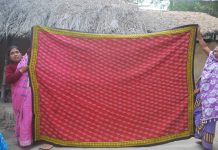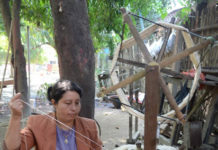Lurik originated from the village of Java. In the beginning, lurik made in a sheet of clothes that functioned as kemben (a fabric that only wrap women torso), stagen (belt from fabric), and as a container for carrying a baby or tools.
Lurik originated from Javanese language that means “lines,” Aside from the function of lurik as wearable clothes, lurik also represents social status during rituals such as mitoni and siraman. Early on, it was very simple, made from combinations of black and white.
From the time of the Majapahit Kingdom, lurik was used by men and women. For women, lurik is the material for kebaya or jarik (a fabric to be wrapped in the waist below like sarong). For men, it is the material of beskap in Solo and surjan in Yogyakarta.
In the traditional market of Solo and Klaten, the traders use lurik as jarik gendong, a bag for carrying their things. Lurik motif names are derived from flora, fauna, or sacred things. Variations in lurik include klenting kuning, sodo sakler, lasem, tuluh watu, lompong keli, kinanti, kembang telo, kembang mindi, melati secontong, ketan ireng, ketan salak, dom ndlesep, loropat, kembang bayam, jaran dawuk, kijing miring, kunang sekebon, gadung melati, yuyu sekandang, lintang kumelap and polos abang. But nowadays the weaver of Lurik is not aware of the traditional motifs. The lurik that made by today’s weavers are in various colours depend on the customer request.
There are two tools for weaving lurik. The bendho is made from bamboo or wood. Usually it is for weaving stagen, a woman’s belt for Javanese clothes. It is called bendho because the tools look similar to a Javanese sabre (bendho in Javanese language). Gendong is for weaving clothes and jarik (long clothes). In the process of lurik production, the weaver sits and puts the tools on her thigh.
The materials for making lurik are cotton fibre, wood fibre, silk fibre, synthetic fibre. The types of lurik that recognised until present days are lurik troso (made traditionally in Troso Village, Jepara, patterned with coloured vertical lines and combined with dolby thread), lurik pedan (from cotton thread in Pedan village, Klaten, where the dyeing process starts from the thread so the same colour is in front and the back of the fabric) and lurik batik (a thickly woven lurik fabric that is coloured through the batik process).
The production process begins with designing the motif, dyeing the thread, and then drying it in the sun. The dried threads are then spun into small twines called kelos/palet. The threads are then arranged into a desirable motif (sekir). The weaver must have a high skill to do sekir, because to make one lurik (width +70 cm), it is estimated, needs more than 2000 sheet of thread. Then as part of nyucuk, the motive is transferred to the weaving tools. The threads are arranged into tools like comba. Two persons involved in this part, one person sorting the threads and the other arrange the thread. Finally, the threads are woven into a lurik.
Mr. Endro Kuswardjo still practices Tenun lurik from his workshop in Yogyakarta (Jl. Taman Wiswo Joyonegaran MG II/942) and sells at Tenun Sutra “Tugu Mas”.
Sources
Library Research – Exhibition Observation Research
Nian S. Djoemana. “Lurik, Garis-garis Bertuah”. Djambatan 2000
Indonesian National Encyclopedia, 1997.
Feti Anggraeni, S.Ant. “Lurik, Dari Masa ke Masa” Majalah Artista No. 1 & 2 Vol 10. 2007.




